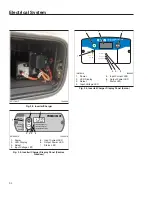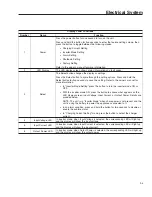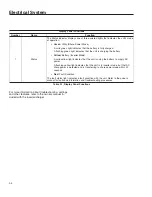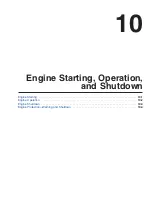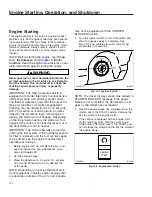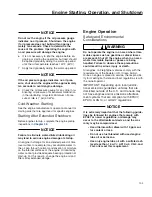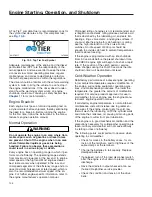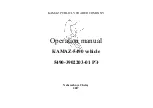
Greenhouse Gas Emissions
and Fuel Consumption
Standards
Vehicles and/or engines manufactured after Decem-
ber 31, 2006 and domiciled in the U.S. or Canada
are required to meet all EPA and NHTSA regulations
effective as of the vehicle build date. Engines manu-
factured between January 1, 2007 and December 31,
2009 meet EPA07 requirements. Engines manufac-
tured between January 1, 2010 and December 31,
2012 meet EPA10 requirements. Engines manufac-
tured from January 1, 2013 meet NHTSA and EPA
2014 fuel efficiency and greenhouse gas emission
standards (GHG14) requirements. Engines manufac-
tured from January 1, 2016 meet NHTSA and EPA
2017 fuel efficiency and greenhouse gas emission
standards (GHG17) requirements.
Model year 2013 and later vehicles meet additional
requirements as specified by GHG14 requirements.
Model year 2017 and later vehicles meet similar re-
quirements as specified by GHG17 requirements.
These vehicles are equipped with components that
increase fuel efficiency and reduce GHG emissions.
Components may include, but are not limited to, low-
rolling resistance tires; aerodynamic devices such as
hood, cab/sleeper extenders, and fuel tank fairings;
vehicle speed limiter; and idle shutdown timer. If re-
placement of any drag-reducing component is re-
quired, the replacement component must meet or
exceed the drag reduction performance of the origi-
nally installed component in order to maintain compli-
ance with GHG14 and GHG17 requirements.
EPA-Regulated Emissions
Aftertreatment Systems
IMPORTANT: Depending on local jurisdictional
guidelines, vehicles that are domiciled outside of
the U.S. and Canada may not have emissions
aftertreatment systems (ATS) that are compliant
with EPA regulations.
NOTICE
Follow these guidelines for engines that comply
with EPA07 or newer regulations, or damage may
occur to the aftertreatment device (ATD) and the
warranty may be compromised.
•
Use ultralow-sulfur diesel with 15 ppm sul-
fur content or less.
•
Do not use fuel blended with used engine
lube oil or kerosene.
•
Engine lube oil must have a sulfated ash
level less than 1.0 wt %; API CJ-4, CK-4,
and FA-4 oils meet this requirement.
IMPORTANT: Using non-specification fuels or
oils can lead to shortened diesel particulate filter
(DPF) cleaning or replacement intervals. For
example, using CI-4 Plus oil with 1.3% sulfated
ash (30% more ash content) may result in the
need for DPF cleaning or replacement 20 to
30% sooner than would normally be required.
IMPORTANT: See the engine manufacturer’s
operation manual for complete details and op-
eration of the ATS.
EPA10 and Newer Engines
The EPA mandates that all engines built after De-
cember 31, 2009 must reduce the level of emissions
exhausted by the engine to the following levels:
•
Nitrogen Oxides (NOx) – 0.2 g/bhp-hr
•
Particulate Matter (PM) – .01 g/bhp-hr
To meet EPA guidelines, engines that are compliant
with EPA10 and newer regulations use an ATS
where the exhaust first passes over the diesel oxida-
tion catalyst (DOC), then passes through the diesel
particulate filter (DPF), which traps soot particles.
The soot is burned to ash during a process called
regeneration (regen). A Selective Catalytic Reduction
(SCR) device is used to reduce NOx downstream of
the engine. After exhaust gases leave the DPF, a
controlled quantity of diesel exhaust fluid (DEF) is
injected into the exhaust stream. In the presence of
heat, DEF is converted to ammonia gas, which re-
acts with NOx in the selective catalyst chamber to
yield nitrogen and water vapor, which exit through
the tailpipe.
Regeneration
The harder an engine works, the better it disposes of
soot. If the exhaust temperature is high enough, a
process called
passive regeneration
(regen) occurs
as the vehicle is driven normally. However, if the en-
gine isn’t running hot enough, the electronic controls
may initiate an
active regen
, whereby extra fuel is
injected into the exhaust stream to superheat and
reduce the soot trapped in the DPF to ash. Active
regen happens only when the vehicle is moving
above a certain speed, determined by the engine
Emissions and Fuel Efficiency
12.1
Summary of Contents for NEW CASCADIA 2016
Page 1: ... NEW CASCADIA Driver s Manual Part Number STI 500 Publication Number STI 500 8 ...
Page 5: ......
Page 11: ......
Page 38: ...f611444 10 31 2016 Fig 3 23 Sample Alert Messages Instruments 3 20 ...
Page 39: ......
Page 93: ......
Page 94: ...8 Cab and Sleeper Features Windows 8 1 Mirrors 8 1 Cab Amenities 8 1 Sleeper Amenities 8 2 ...
Page 99: ......
Page 125: ......
Page 134: ...14 Steering System Power Steering System 14 1 ...
Page 145: ......
Page 146: ...16 Manual Transmissions and Clutch Eaton Fuller Manual Transmissions 16 1 Clutch 16 1 ...
Page 149: ......
Page 150: ...17 Drive Axles Interaxle Lock Tandem Axles 17 1 Driver Controlled Differential Lock DCDL 17 2 ...
Page 164: ...19 Trailer Couplings Holland Trailer Coupling 19 1 ...
Page 177: ......
Page 191: ......
Page 198: ...25 Specifications Fluids and Lubricants 25 1 ...

